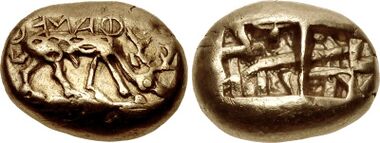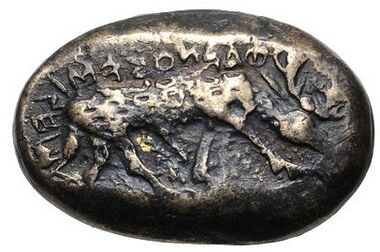Earth:Phanes (coin issuer)

Phanes is a name on a series of early electrum coins, the most ancient inscribed coin series at present known, from Caria, Asia Minor. This group of coins has Greek legends. The longer legend may read (some letters are unclear and disputed)[1] "Phaenos emi sema" (ΦΑΕΝΟΣ ΕΜΙ ΣHΜΑ), which may be translated as "I am the badge/mark/symbol of Phanes" or "I am the sign of the bright one".[2][lower-alpha 1] The shorter legend is simply "Phaneōs" (ΦΑΝΕΩΣ).[4]
The coins of Phanes are amongst the earliest of Greek coins. One, a hemihekte (a twelfth stater) of the issue, was found in a jar in the foundations of the Temple of Artemis at Ephesus, the earliest known hoard of coins.[5] Only six specimens of this coin type are known.[6]
Possible identifications

Phanes cannot be identified with certainty. He might have been the successful mercenary Phanes of Halicarnassus, described by Herodotus as serving first the Egyptian pharaoh Amasis II and then the Persian king Cambyses II in his invasion of Egypt.[7] The coins might be associated with the primeval god Phanes, whose name means "light" or "shine", or that might have been an epithet of the local goddess identified with Artemis. Barclay V. Head found both suggestions unlikely and thought it more probably "the name of some prominent citizen of Ephesus".[8]
Notes
References
- ↑ Babelon, Ernest Charles François (1901). Traite des monnaies grecques et romaines, deuxieme partie. Paris: Ernest Leroux. pp. 53-68. https://archive.org/details/traitdesmonnaie01babegoog/page/n43/mode/2up. Retrieved 25 October 2021.
- ↑ Newton, Charles (1870). The numismatic chronicle and journal of the Royal Numismatic Society. 10. The Royal Numismatic Society. pp. 238. https://archive.org/details/numismaticchron49britgoog/page/n342/mode/2up.
- ↑ Kaplan, Deniz (2000). "Common traits on seals and coins of the Achaemenid period in an Anatolian context". in Casabonne, Olivier. Mécanismes et innovations monétaires dans l’Anatolie achéménide. Numismatique et Histoire. Actes de la Table Ronde d’Istanbul, 22-23 mai 1997. Istanbul. Institut Français d'Études Anatoliennes. p. 215. https://www.persee.fr/doc/anatv_1013-9559_2000_act_12_1_959. Retrieved 26 October 2021.
- ↑ "Electrum stater inscribed with the name of Phanes". British Museum. 2011-09-29. https://artsandculture.google.com/asset/electrum-stater-inscribed-with-the-name-of-phanes/eQGeTjUPnu5aCA. Retrieved 2021-10-26.
- ↑ Kurke, Leslie (1999) (in en). Coins, Bodies, Games, and Gold: The Politics of Meaning in Archaic Greece. Princeton University Press. pp. 6–7. ISBN 0691007365. https://books.google.com/books?id=9eFxCAAAQBAJ&pg=PA6.
- ↑ "White Gold: Revealing the World's Earliest Coins at the Israel Museum, Jerusalem". https://museum.imj.org.il/exhibitions/2012/whitegold/Animals.html.
- ↑ Gardner, Percy (1878). The numismatic chronicle and journal of the Royal Numismatic Society. 18. London Royal Numismatic Society. pp. 262. https://archive.org/details/newnumismatic18royauoft/page/262/mode/2up. Retrieved 2012-05-21.
- ↑ Head, Barclay V. (1911). Historia Numorum, A Manual of Greek Numismatics, New and Enlarged Edition. London: Clarendon Press. http://snible.org/coins/hn/ionia.html#571. Retrieved 25 October 2021.

